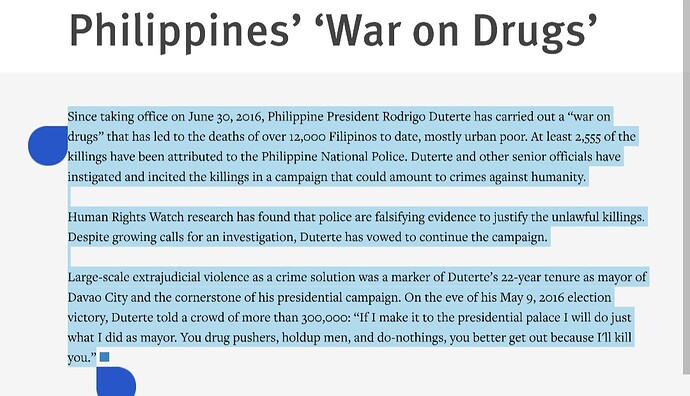basehan nayan ng ejk?? pero kung titingnan mo yung buong picture, maraming pinatay during his term that led to Human Rights Violation.
as if it fixed the main core of the problems lol, still criminals and druglords are still out there and an never ending problem over a decade. As if killing them fixes the main problem.
The downsides of the anti-drug campaign in the Philippines that led to over a million people “surrendering” include widespread human rights violations, a large number of extrajudicial killings, a severe impact on the urban poor, and the erosion of the rule of law and accountability.
Key downsides include:
Mass Killings: The primary downside was the high death toll. Government figures state over 6,200 people were killed in police operations, while human rights groups estimate the total number of deaths (including those by vigilantes) could be between 12,000 to over 27,000. These killings have been widely criticized as unlawful and potentially amount to crimes against humanity.
Forced “Surrenders” and Lack of Due Process: Many people “surrendered” out of fear of being killed otherwise, rather than voluntarily. Police were allegedly given quotas for surrenders and some individuals were arrested on trivial charges to meet these quotas. The “knock and appeal” (Tokhang) method was inherently coercive and used a fear-based strategy.
Targeting of the Poor: The vast majority of those killed or who surrendered were from poor and marginalized communities, leading to criticism that the campaign was anti-poor and failed to address the root causes of drug use or target high-level drug lords.
Negative Social and Economic Impacts: The deaths of primary income earners often drove affected families deeper into poverty, causing children to drop out of school due to lack of financial support and stigma.
Rule of Law Erosion and Impunity: The campaign fostered a climate of impunity where police officers and vigilantes faced little to no accountability for the killings. There was evidence of falsified evidence and staged crime scenes, and critics of the campaign, including journalists and a senator, faced harassment, intimidation, and politically motivated charges.
Inadequate Rehabilitation: The sheer number of surrenders overwhelmed the existing healthcare and rehabilitation systems. Many “surrenderers” were forced into non-evidence-based, unhelpful, and potentially rights-violating “treatment” programs, with a lack of adequate aftercare and reintegration support.
Failure to End the Drug Problem: Despite the high number of surrenders and deaths, the “war on drugs” failed to significantly decrease the availability of drugs or fully address the public health aspects of drug use.

